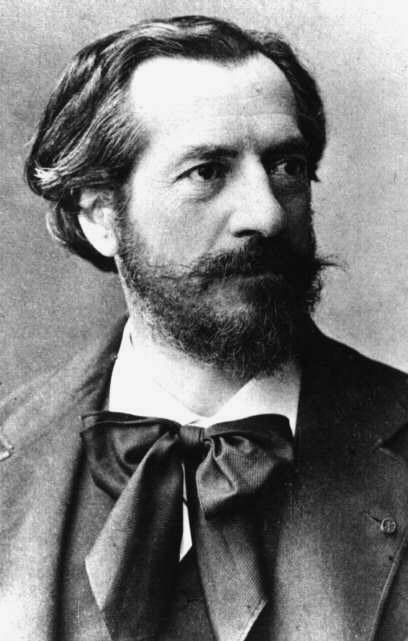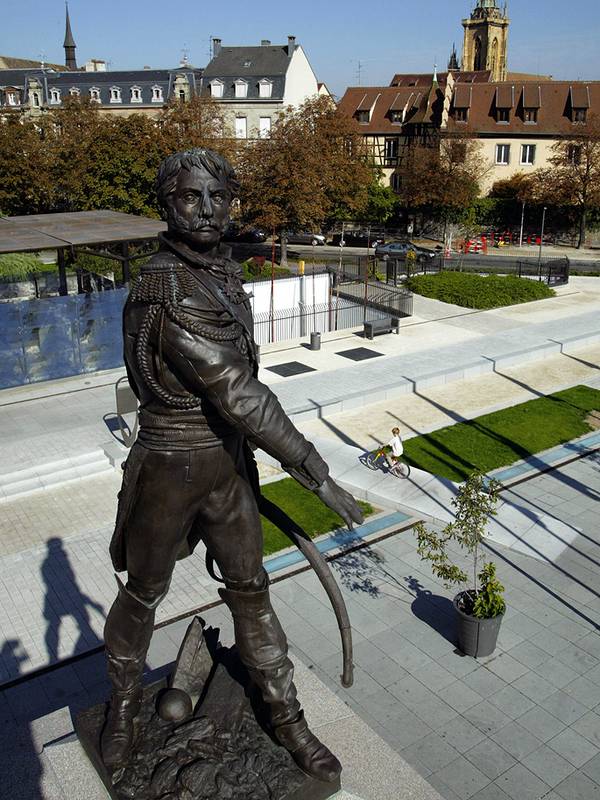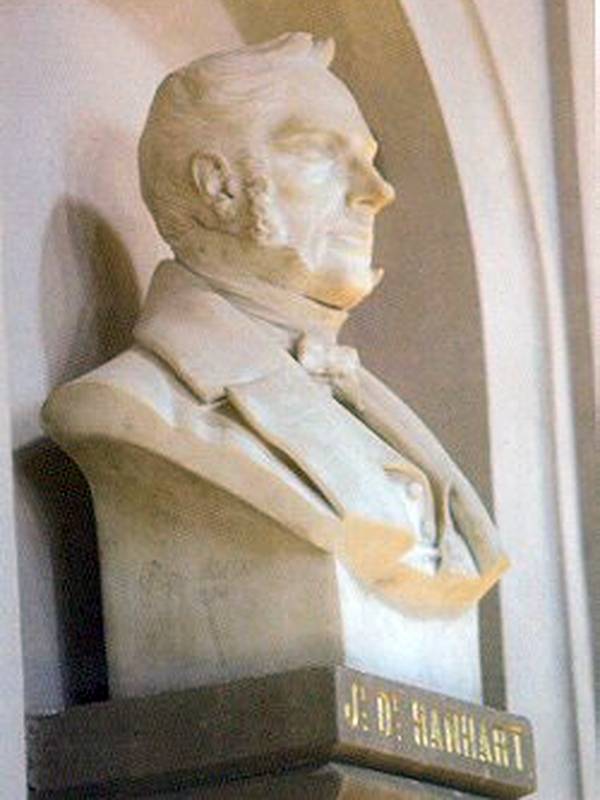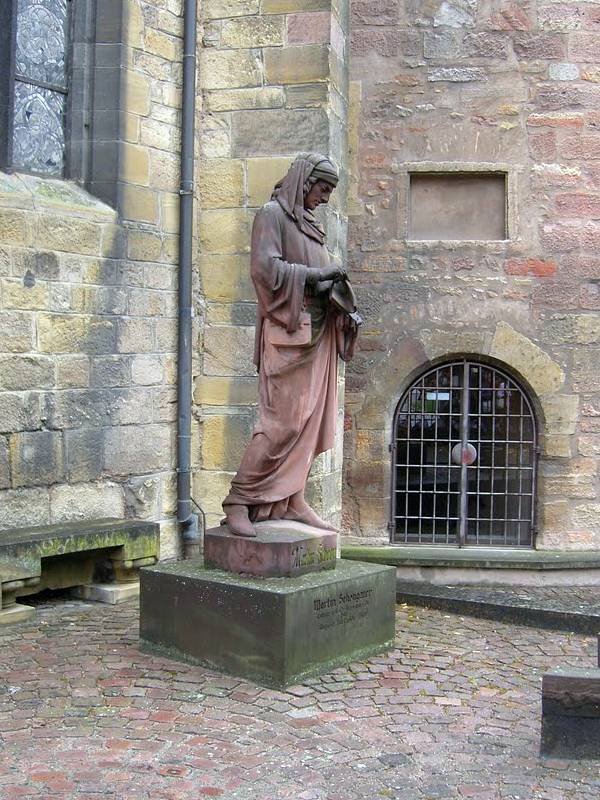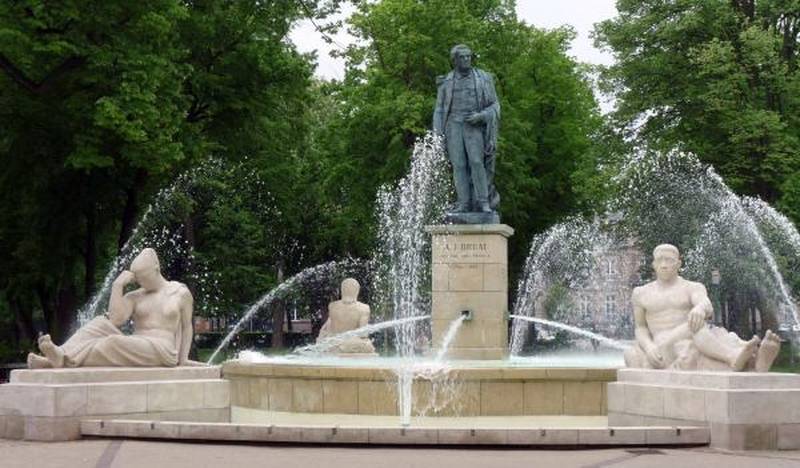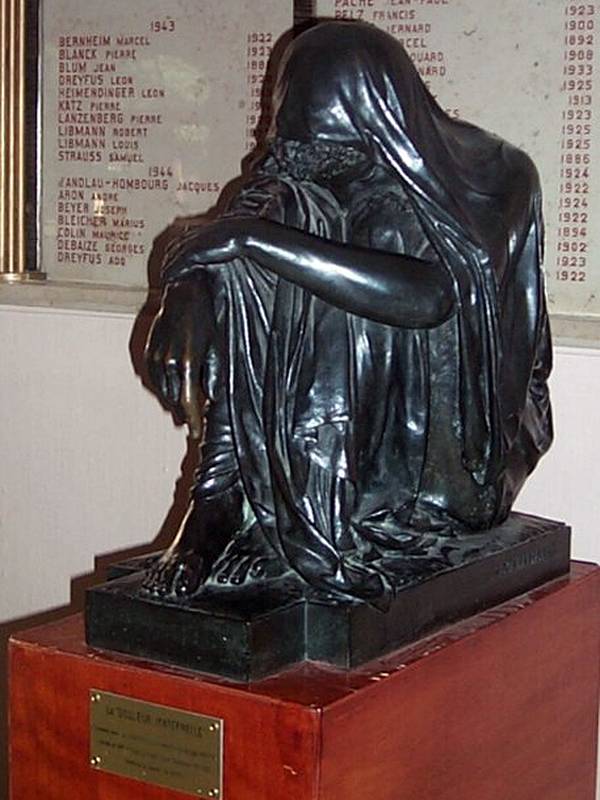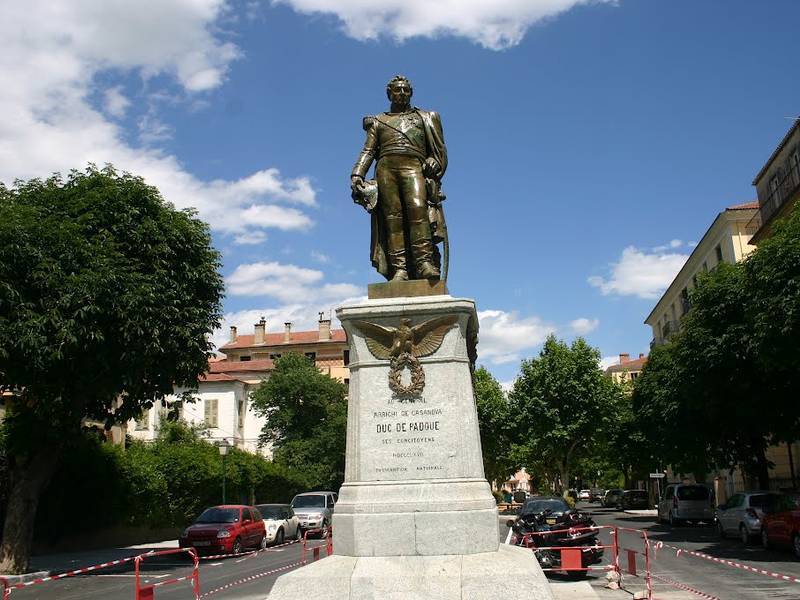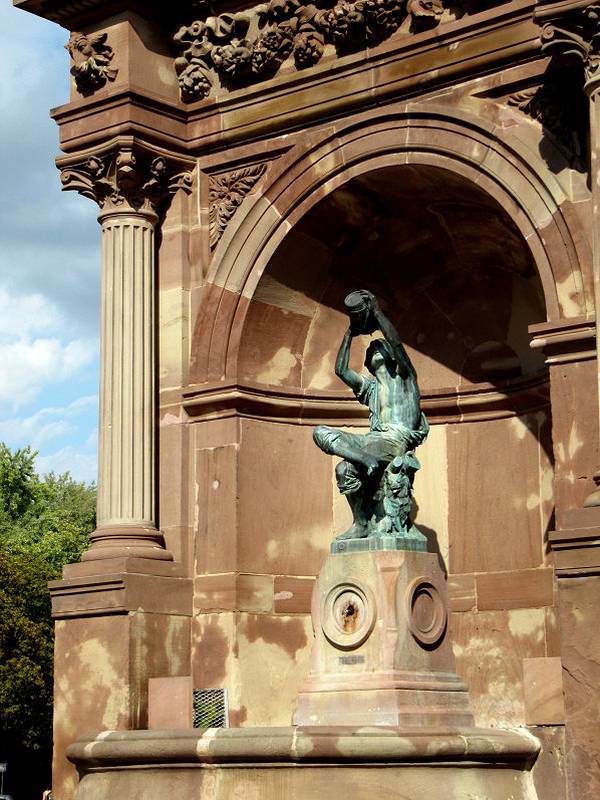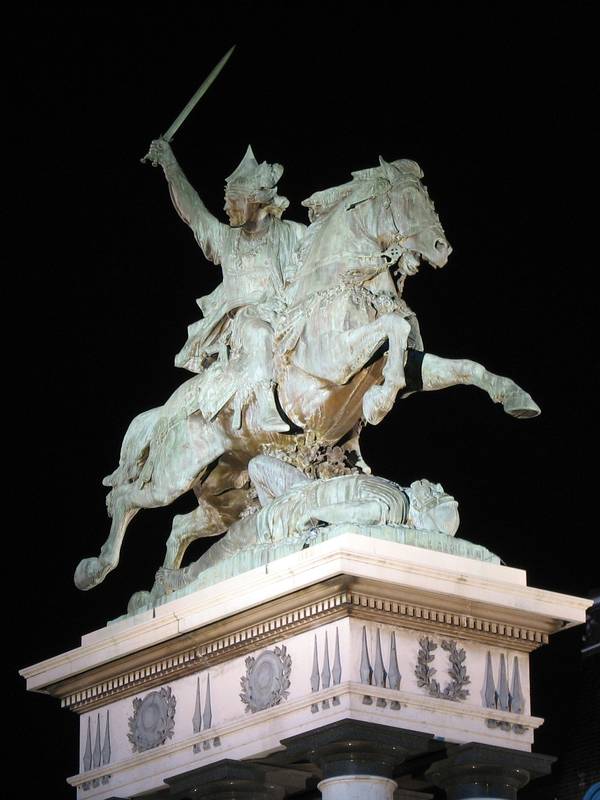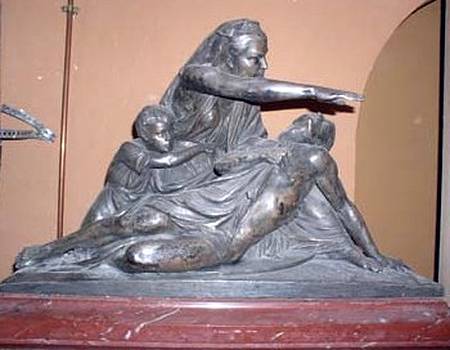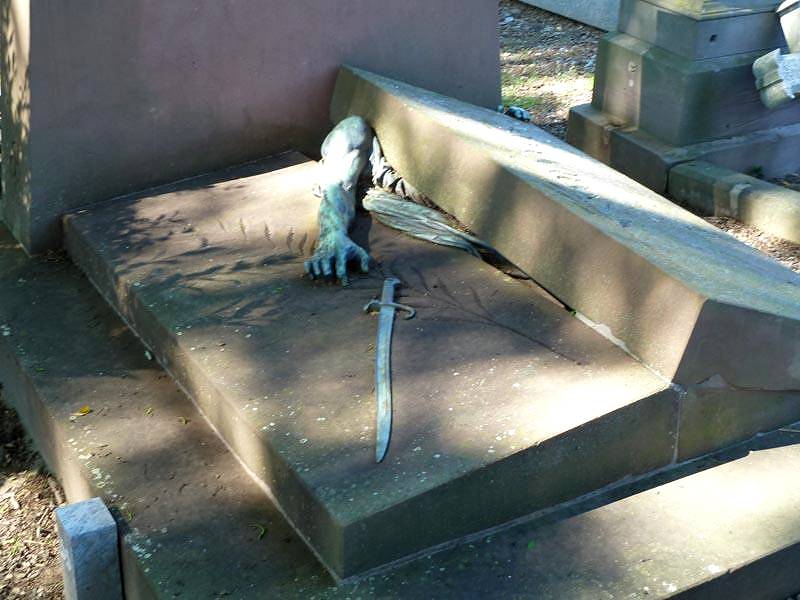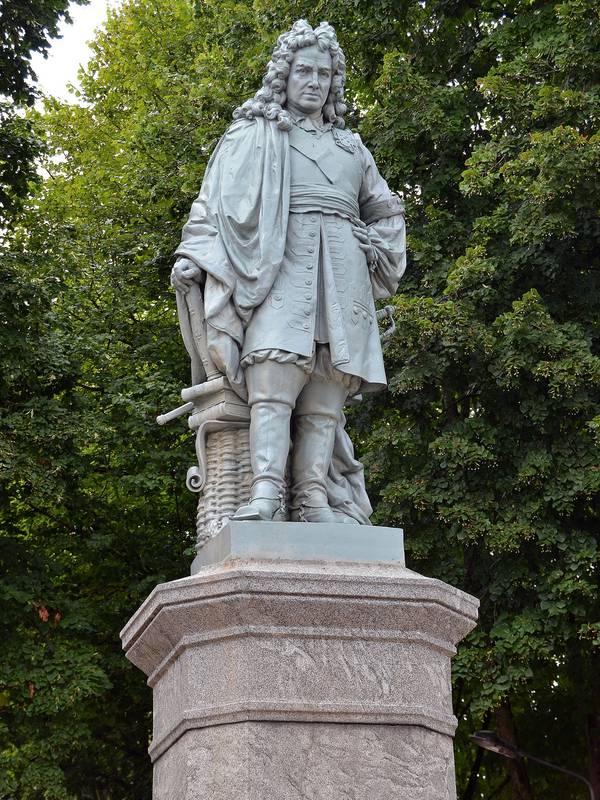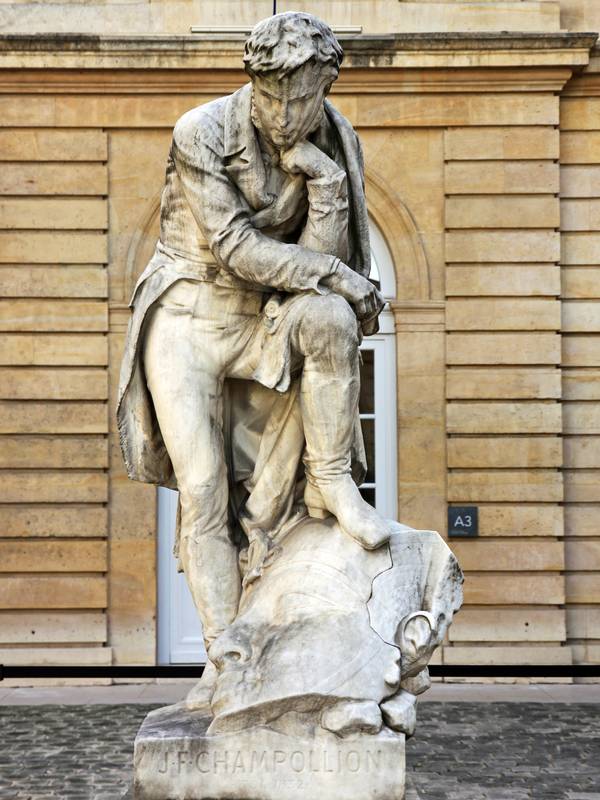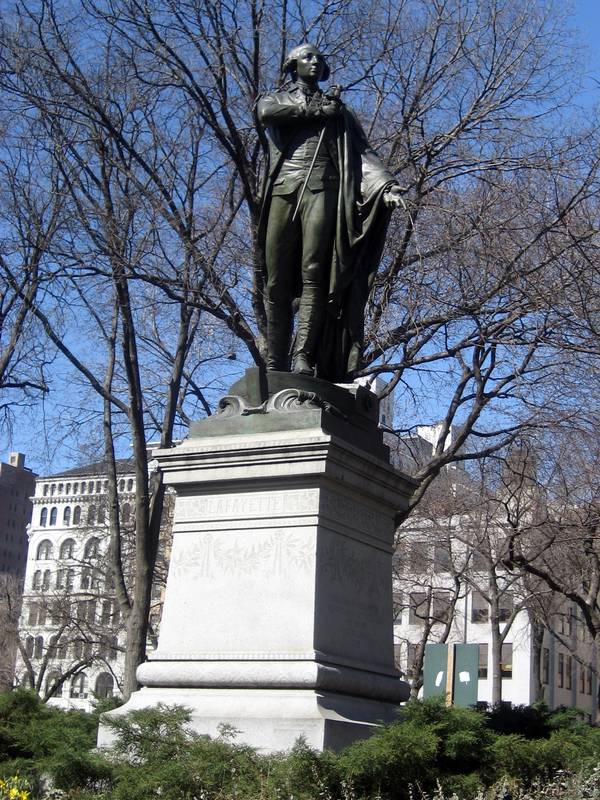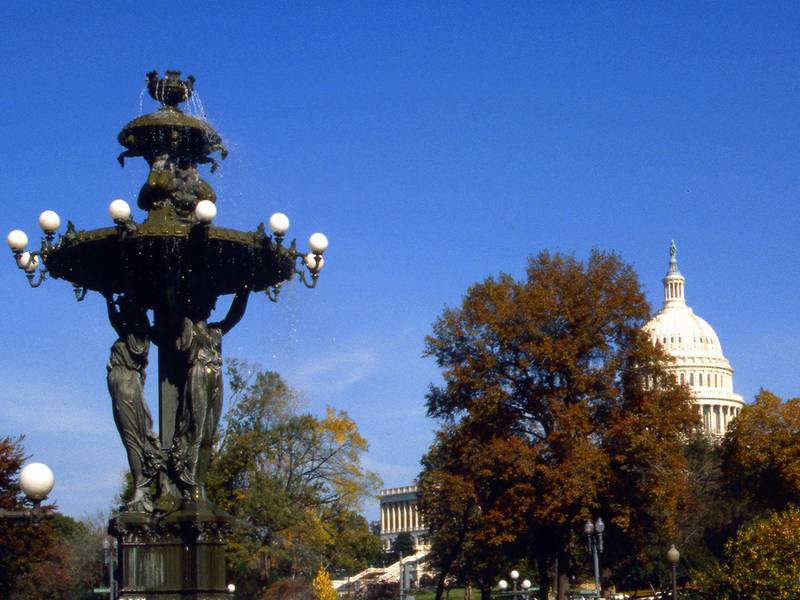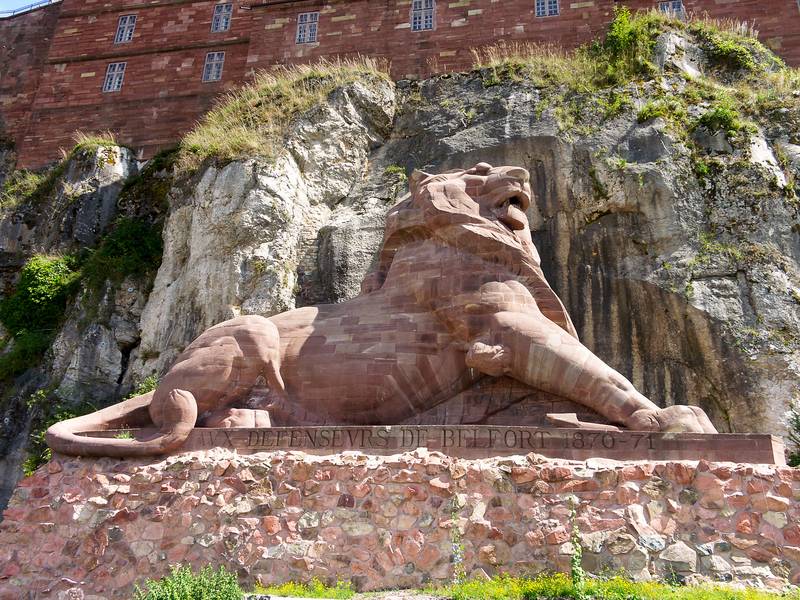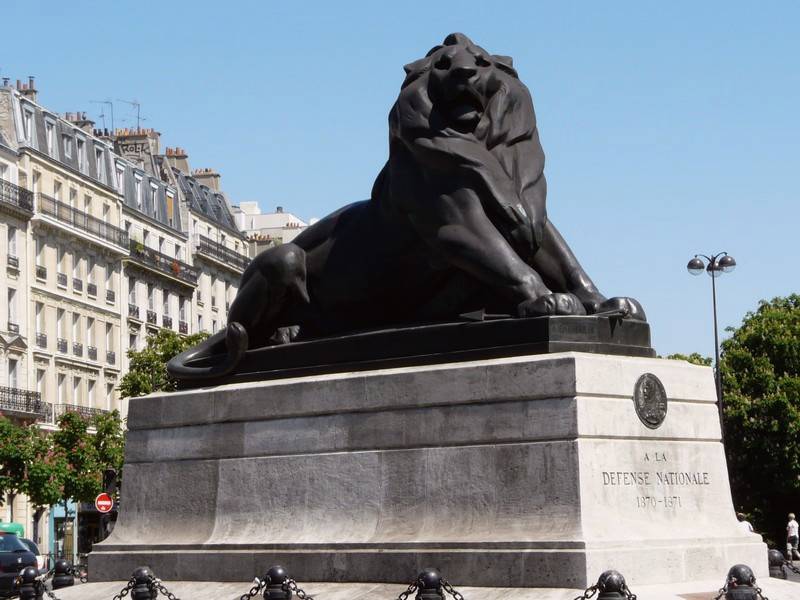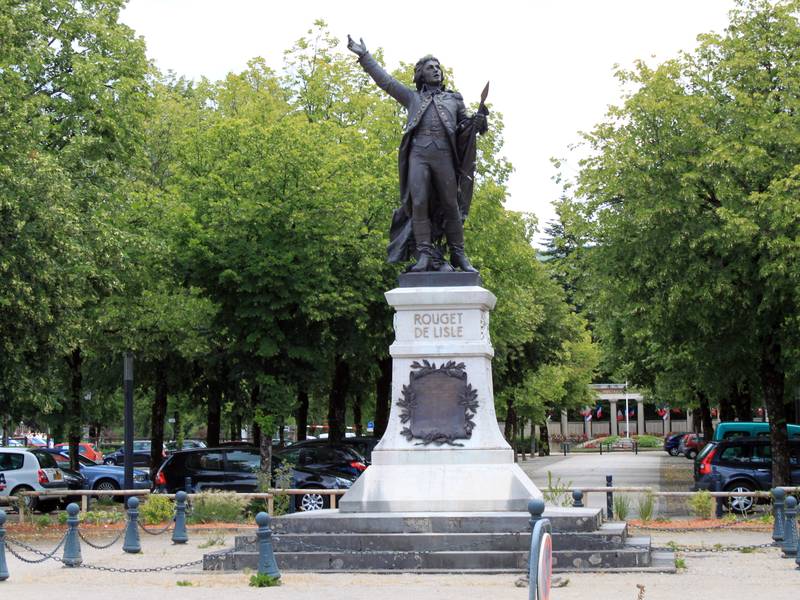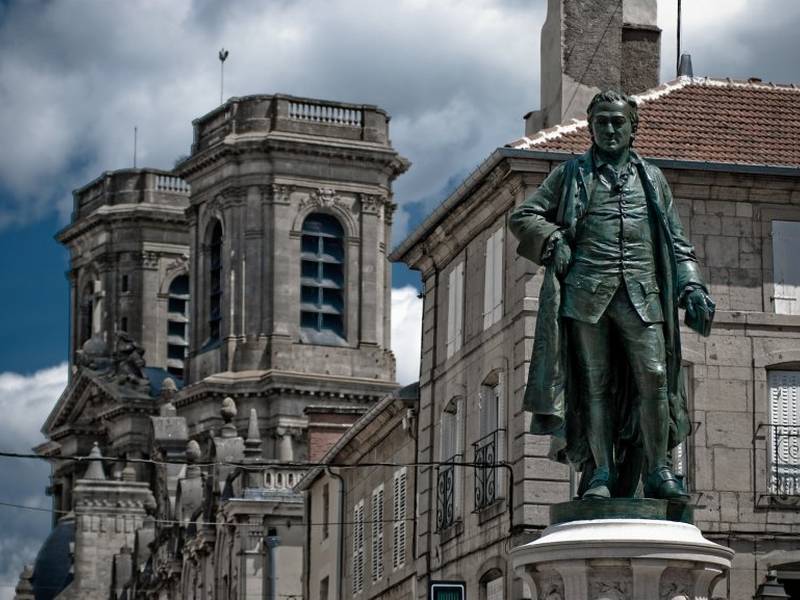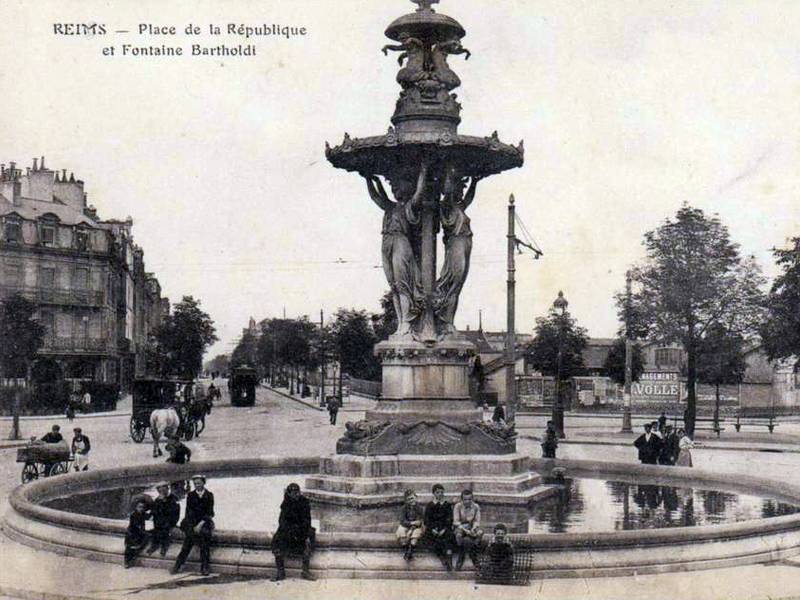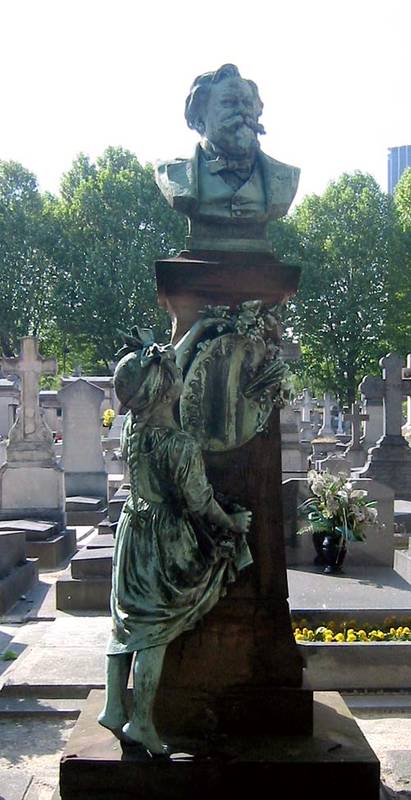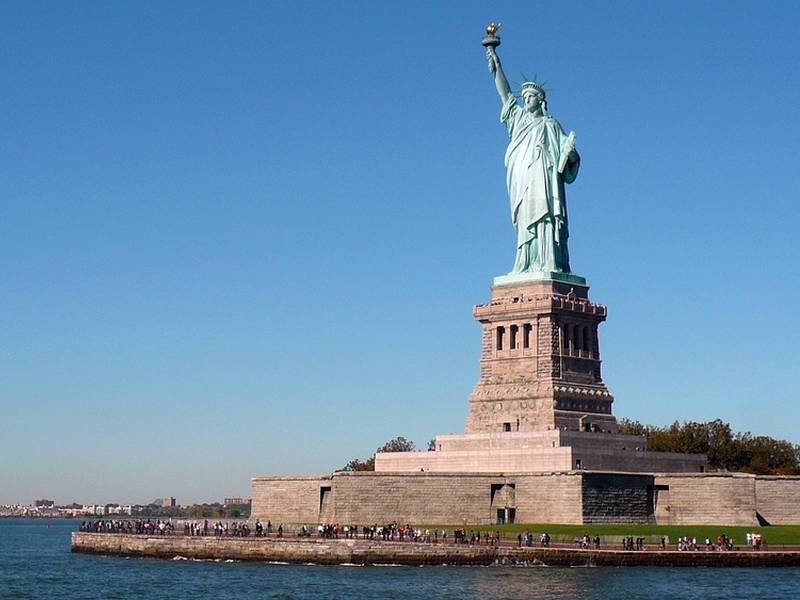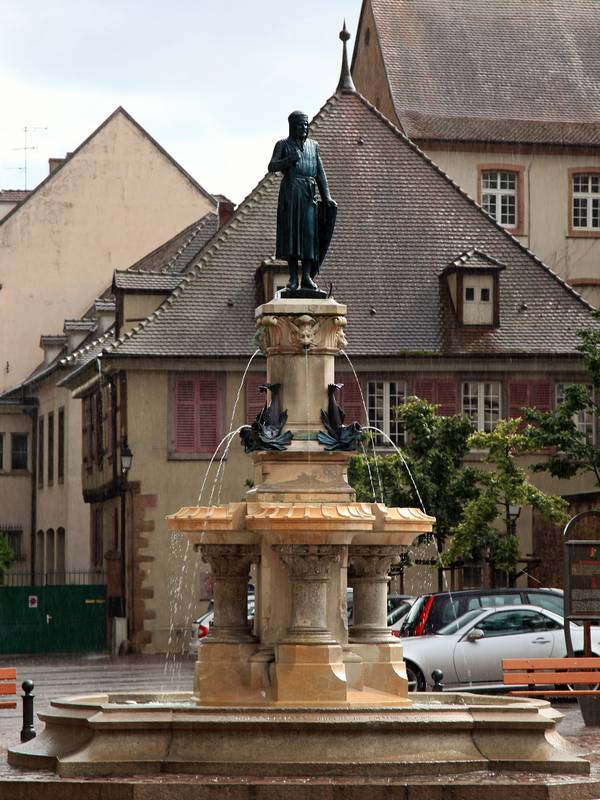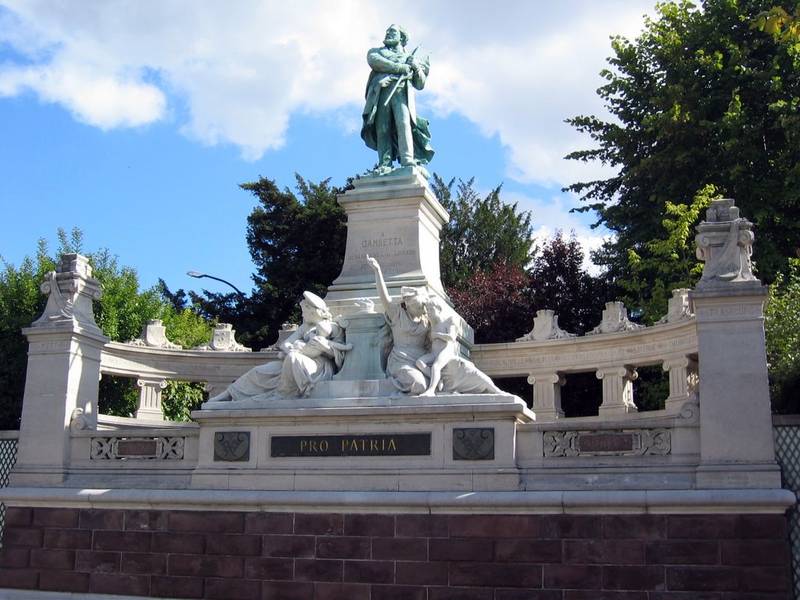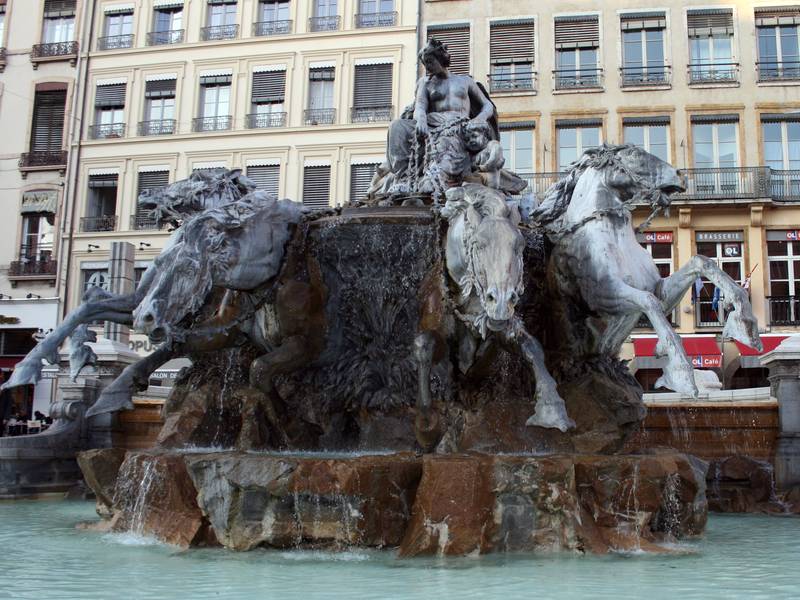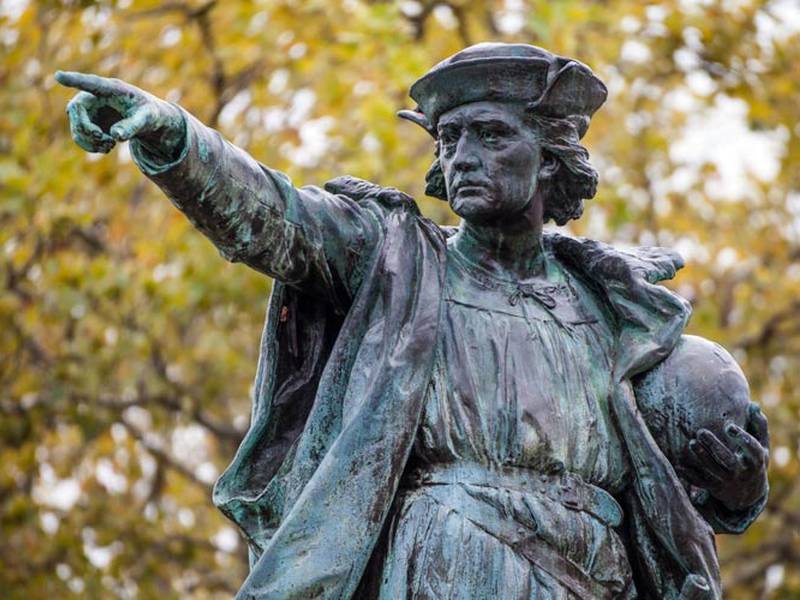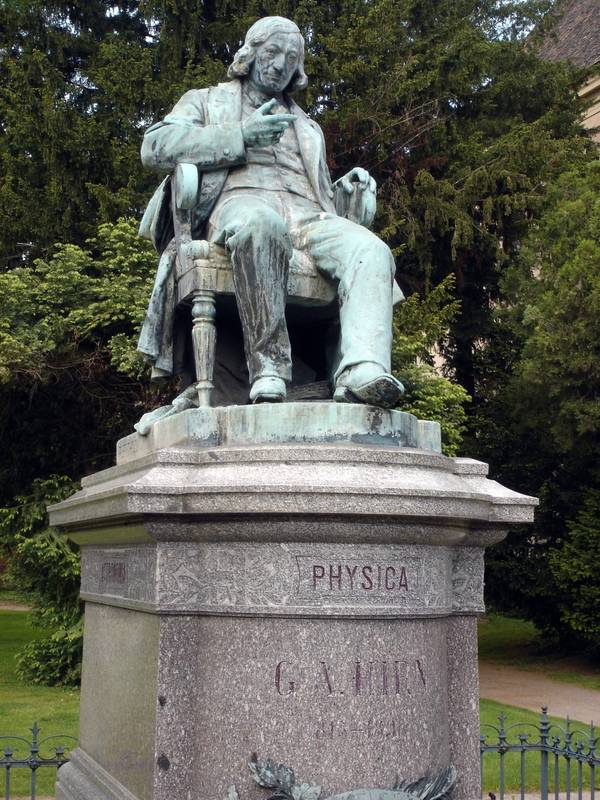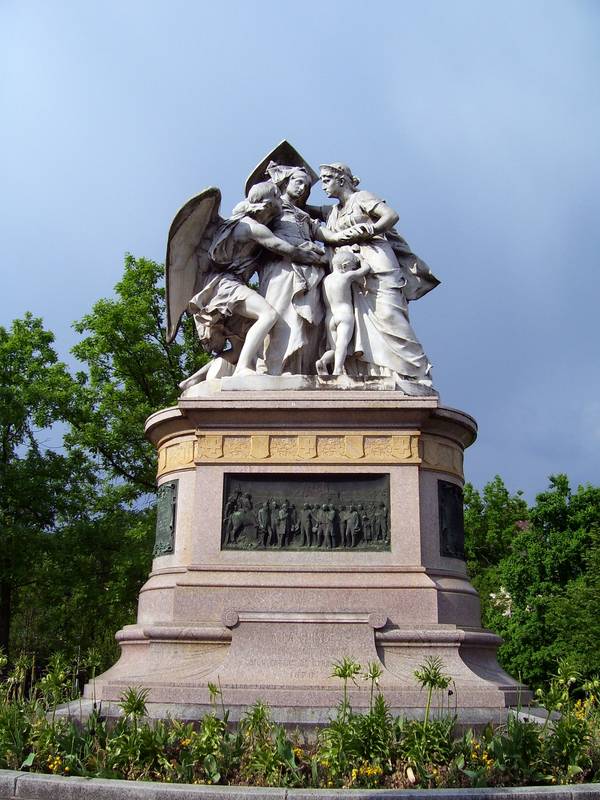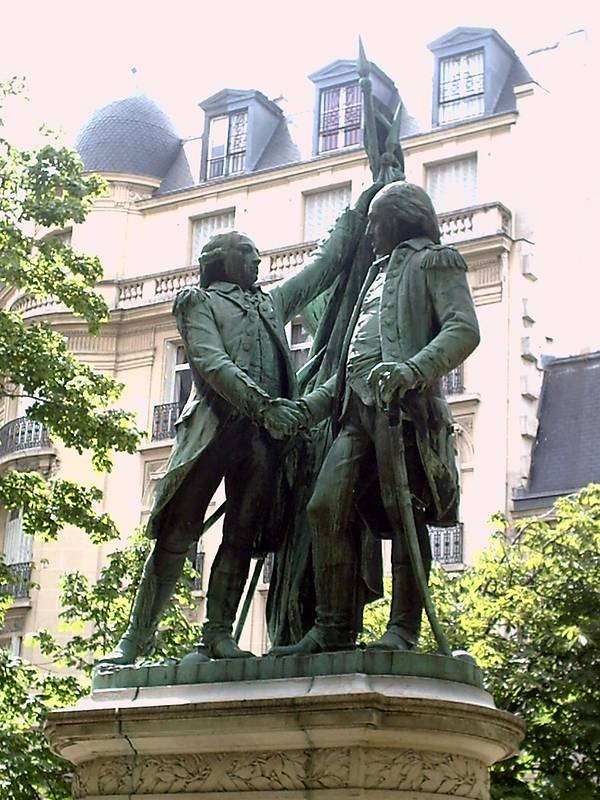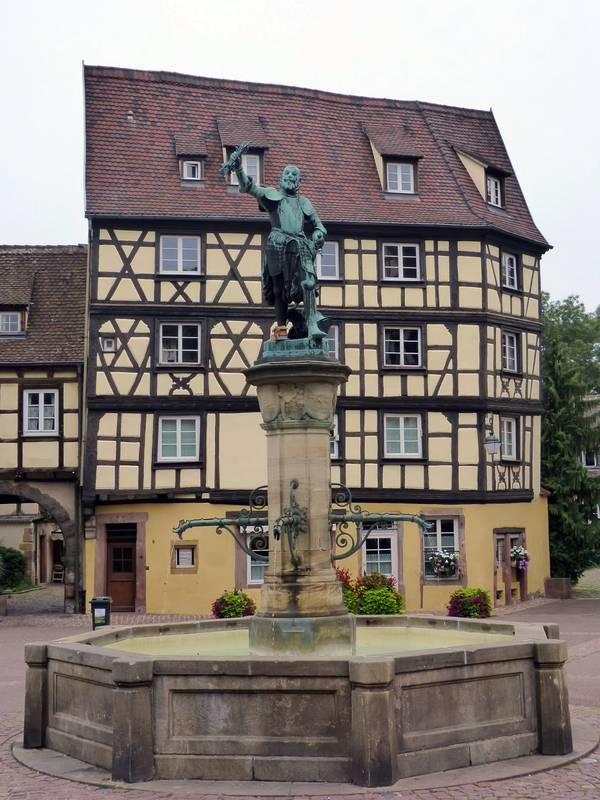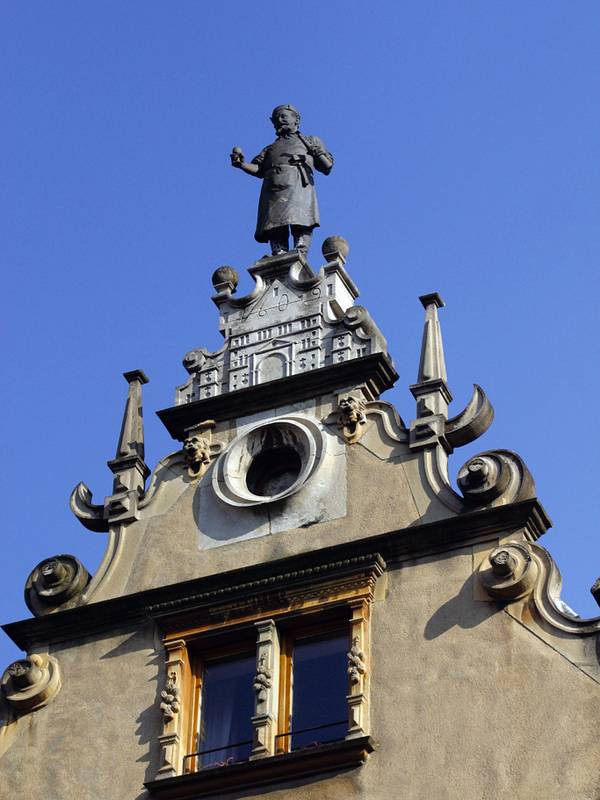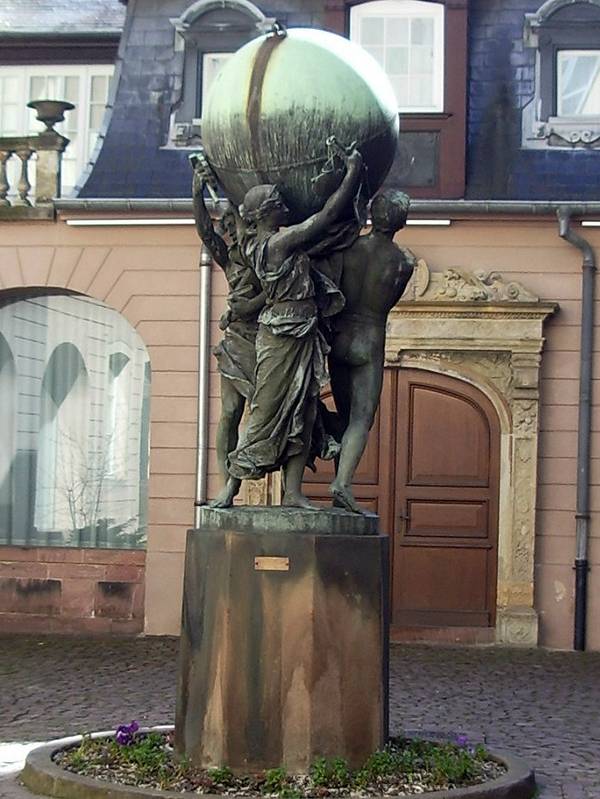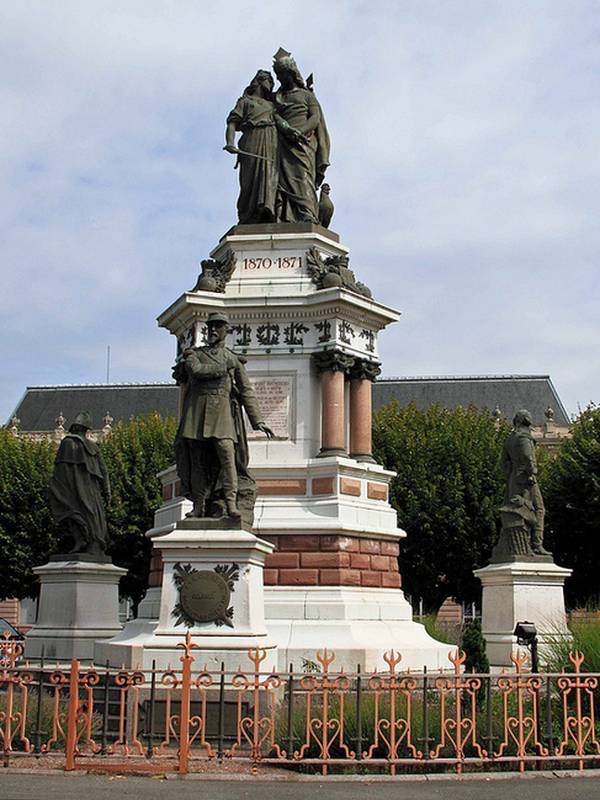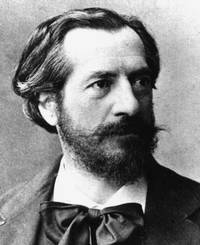
Auguste Bartholdi
Biographie
Frédéric Auguste Bartholdi was a French sculptor of the nineteenth century. He is internationally known for being the author of the Statue of Liberty. The city of Colmar, where he was born, keeps many traces of his business.
The first years
Auguste Bartholdi was born in Colmar in 1834. He comes from a prosperous family from the German Rhineland. His father, Jean-Charles, was an official who parlayed family wealth, they had many properties which ensured him his lifestyle. Unfortunately he died young, in 1836, when his son Frederick was only 2 years. His wife Charlotte Augusta then manages the fortune of her husband with caution, allowing his son to enjoy a windfall that will put them all to freedom from want. For Augustus, as he will be called later, had three brothers, two of whom will die young. The survivor was a lawyer, but the disease prevailed and he had to be interned.
On the death of his father, the family moved to Paris at 30 rue merchants. This address is now the Bartholdi Museum. Auguste studied at the Lycée Louis-le-Grand, where he graduated in 1852, then at the National School of Fine Arts, where he studied architecture and painting.
In 1855 and 1856 he made a trip to Egypt and Yemen, which will mark the journey to the end of his life, revealing contrasting countries. This trip he made with his friends Edward-Auguste Imer, Jean-Léon Gérôme and Léon Belly, gives him the first ideas of monumental sculptures. He took the opportunity to return to France a large amount of evidence of this journey through many photos, drawings or engravings.
Early in his career
His professional career began in 1852 in Paris, when he moved to its own premises. He received his first major command through his hometown, Colmar, who offers to perform a statue of General Rapp (1856). The following year, he made plans for the architectural complex of the Palais Longchamp in Marseille. In 1864, the year he was made a Chevalier of the Legion of Honour, he realizes the fountain dedicated to Admiral Bruat, also in Colmar. The previous year he had already made in Colmar another monument dedicated to Martin Schongauer, that one. In 1865 he participated in the famous meal offered by Edouard de Laboulaye, a republican american convinced, meal during which was issued the idea to offer to the young nation of United States to seal a colossal statue of Franco-American friendship . Bartholdi was chosen as architect and sculptor, based on sketches he had made to the attention of the Egyptian Khedive, a project that premise will be denied later. The following year, he made a bust of Laboulaye, his friend. In 1867 it is the city of Corte, Corsica, who asks him a statue of General Arrighi de Casanova.
In 1869 he made a second trip to Egypt, this one specifically to propose the construction of a gigantic statue of woman holding a torch to put the Suez Canal input (a creation of French engineering), and would be called "the East enlightening the World." But this project was refused by the Khedive of Egypt, Ismail Pasha, by lack of funding for such work. Back in France he continues statuary of his hometown and made the statue of the little wine, so in Colmar.
Influence of the 1870 war
But the war between France and Prussia catches up (1870). Prussia attacks and invades the French territory, is besieged Paris. Colmar is of course one of the first towns attacked, on the eastern front, but it's also the only one to resist the invader. Bartholdi, having been forced to fight, finds squadron leader of the National Guard, where he holds a job aide to General Garibaldi. Exiled in Bordeaux, near Colmar and Paris, he mopes and chose to leave France, until the war ends. He worries about the length of the journey, not knowing when France will be returned to him in a stable political condition. History proved him right because at the end of the war it was the Paris Commune, which causes significant political unrest in France, unrest did not stop with the election of the very patriotic Thiers.
First trip to the US
Bartholdi so chooses from the USA (10 June 1871), among other to choose the location of the future statue, but especially to know the country and to make the necessary contacts for the building of his statue. This statue, there is much thought during the two years. This period (1870-1872) saw the transformation of the Egyptian project in a more traditional project more feasible. Bartholdi used this time to redefine the design of the statue, as envisaged as a gift to the United States. He made several models, several sketches, each one different from the last. He replaced the oriental dress with a classical toga, hanged the left arm, made tests by making him hold broken chains, etc. It was during this period that actually created the Statue of Liberty in the form that we know today.
In the United States, Bartholdi began to search the ideal location of his statue. He knew she had to be in New York, but several websites available to him. He brushed Battery Park, south of Manhattan, because of the horizon blocked by skyscrapers and Central Park, not symbolic enough. Left New York Bay at the entrance of the city, ideal situation because it would be seen by anyone entering or leaving the city. Here he chooses to make, on a small island with a former military fort downgraded.
During his trip he met several personalities, people in contact with Laboulaye. Upon his arrival he found that there was no enthusiasm for his project. Worse, every time he spoke, he faced great skepticism on the part of his interlocutors. In fact, they do not see the value of building a statue in honor of Liberty at home, especially since they would have had the pedestal for their charges. Besides the concept of freedom, the United States, is acquired since independence, young. They did not need a monument to remind them. Finally, the last argument, their economy was booming, they were thinking of making more dollars as statues. All this meant that Bartholdi had to search a while before meeting the right people, those of "the Union League Club," in Philadelphia. They shared the French point of view, but did not see their interests in building. So they also refused financing base.
However, they proposed to Bartholdi to participate in the centenary exhibition, the exhibition made in Philadelphia during which were presented the arm and torch of the statue. It was also during this exhibition he met Morris Hunt, the future architect of the base. Bartholdi executed a statue of Lafayette, which was shown during the exhibition before its installation in Washington. At the end of this year 1871, he met with President Grant, who assured him the declassification of strong Bedloe, making installation realization of the future statue in New York Bay.
When the municipality of Paris ends and the Third Republic is set up he returned to France to continue his career as a sculptor.
Again installed in its premises in Paris in 1872 he received the command of the funerary monument of national Colmar Guards monument that was destroyed during the war and illustrates the bravery of facing the invaders in Colmar. He also gets his first commission abroad, always in 1872, with demand coming from Boston for the realization of the reliefs of the Unitarian church.
Construction of the Statue of Liberty
From 1874 he begins the work of the Statue of Liberty, after acceptance of the final model. This work took place in Paris until 1884. He began with the most impressive elements to quickly show the progress of work and influence campaigns donations to finance its work. This was done primarily the arm holding the torch and head.
During this ten year Bartholdi not devoted only to his, he made some other works in parallel. The description of how the statue was built is located on a special page of this website. (Click here)
In 1875 Auguste Bartholdi married Jeanne-Emilie Baheux (15 December) in Newport, Rhode Island (USA). He met this woman in France, and she was also left for the Americas, but in Montreal it. Having found the other side of the Atlantic, they took the opportunity to marry. Bartholdi had gone there to perfect his colossal statue of project and place a new order for the city of New York, one: the statue of Lafayette. He will be invited to participate in the Centennial Exposition jury in Philadelphia (1876), in which exposure was exposed arm of the Statue of Liberty, completed quickly and urgently sent to the United States to help with the fundraiser for fund the base of the statue, the work can begin without the assurance of enough money to finish it. Note that this exhibition had put forward a very talented architect known in the United States, Morris Hunt. This was illustrated by the implementation of many large homes for wealthy families. It is he who will be chosen to build the pedestal of the Statue of Liberty.
On his return to France Bartholdi devotes much of his time to the completion of the Statue of Liberty (until 1884), in Parisian workshops "Gaget, Ghautier and Co.". This statue, which is his masterpiece, was staged in central Paris in 1885, then disassembled and reassembled definitively in 1886 in the United States. Meanwhile he will have delivered some other works: Capitol Fountain in Washington (1878), the Champollion monument in Paris (1878), the Gribeauval monument in Paris (1879), the Lion of Belfort (1880) and its replica Copper in Paris (monument of National Defence, Denfert-Rochereau) and the statue of Rouget de Lisle in Lons-le-Saunier (1882) and the statue of Diderot in Langres (1884). In 1885 he went for the third time in the United States to follow the construction of the base, told Morris Hunt. It will start this trip the following year for the inauguration of the Statue of Liberty October 26, 1886, will be his last trip to the United States.
The age of maturity
The end of his career is marked by an impressive order of succession, he realizes every year: the monument Roesselmann (Colmar, 1888), the monument Hirn (Colmar, 1890), the monument Gambetta (Sevres, 1891) the fountain in Place Bellecour (Lyon, 1892), the statue of Columbus (Chicago World's Fair, 1893), Switzerland rescuing Strasbourg (Basel, 1895), and the same year the Lafayette and Washington (Paris) the Schwendi monument (Colmar, 1898), and the group of the world and support Great statue of Cooper (Colmar, 1902).
In 1903 he produced one of his finest works in France, the monument to the glory of Vercingetorix in Clermont-Ferrand. This is his last major achievement.
His legacy
Auguste Bartholdi died October 4, 1904 in Paris of tuberculosis. He is buried in the cemetery of Montparnasse, in the 28th division.
The house Bartholdi in Colmar, still exists, it has been transformed into a museum in 1922. The house was sold to the city of Colmar by his widow in 1907, together with his models, his sketches, his memories and all that connected with his professional activity. To honor him, the city of Colmar made him a posthumous monument erected. In 1912, the last statue of Bartholdi was inaugurated in Belfort, it was his work "Monument of the three seats," he could not finish. Auguste Bartholdi was a freemason, he joined the Alsace-Lorraine Lodge Paris in 1875.
See as well: Bartholdi Museum Colmar.
Bartholdi, a free spirit?
If Auguste Bartholdi was able to do what he wanted as part of his job is primarily because it has not had to bear a heavy financial burden, either to pay for school, during his youth, or later, to live simply. He did not even have family dependents, marrying later and have not had children. In fact, all expenses were borne by his mother Charlotte who assumed expenses on the family heritage. This makes it very independent sculptor in his trade, in his daily life, but required him to account for his mother, and that until she died in 1891. The mother and his son have had all their lives a symbiotic link and passionate to the point of passing the wife of Augustus, Jeanne, in the background. The proof of this is provided by couriers they exchanged, letters in which Emilie Jeanne Baheux was only seen as the erased person Augustus thought would present to his mother. He did not hesitate to lower it to please her, to lie too: He always presented as being younger than she really was, to make him think she manage to make it a heir, when he knew very well that they had encountered too late to think of starting a family.
What represented the Statue of Liberty Bartholdi for?
Just a tremendous job, a good part of his life, for the statue took him 20 years of his life. However it was not a job that has cornered the full time because he proposed other works in parallel to this work. Auguste Bartholdi is the author of 35 statues, including the famous "Vercingetorix", in Clermont-Ferrand, or the lion of Belfort. This is also after completing the latter he devoted himself to further way to the project of the Statue of Liberty.
List of works of Auguste Bartholdi in the World
The list below is that of Auguste Bartholdi works made during his lifetime in chronological order. It is not comprehensive because it had a very large number of statues and monuments, hard to get completely.
Click on the titles for the photo and a short description.
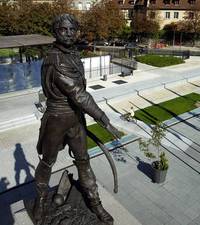
General Rapp
1856 : Monument of general Rapp
This is the first statue of Bartholdi, he realized at the early age of 20 years. It is bronze. It represents the general Rapp Empire (1771-1821), born in Colmar. Made in 1854, it was installed and inaugurated in 1856. It was pulled down by the Germans in 1940, then restored in 1945 and turned over to a new base, identical to the previous, enthroned in 1848. Before the statue was in Colmar presented at the Universal Exhibition of 1855, the Champs Elysees.
1857 : Palais Longchamp water tower
In 1857 the Mayor of Marseille Jean-François Auguste Bartholdi Honnorat asks a project for the construction of a water tower in Marseille, the building became an urgent response to outbreaks of cholera. It was absolutely necessary to bring clean water into the city as soon as possible. The draft Bartholdi was unfortunately rejected because it seemed inappropriate. It was originally composed of two buildings separated by a central water tower, and the project was improved with the creation of a large gallery. The successful project, directed by Henri Espérandieu, taking some elements of Bartholdi project, it instituted a trial succession to highlight plagiarism, but was systematically rejected.
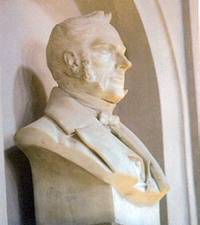
Funeral medallion to Jean-Daniel Hanhart
1857 : Funeral medallion to Jean-Daniel Hanhart
Jean-Daniel Hanhart was a contemporary of Auguste Bartholdi, Colmar like him. Wealthy, he bequeathed a very large sums to local parishes to his death. In recognition of this gesture the religious community of Colmar made him do a bust in his likeness, bust that was made free by the sculptor to the good relations they maintained.
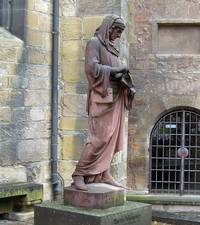
Martin Schongauer
1860 : Statue of Martin Schongauer
Martin Schongauer was a painter and engraver of the fifteenth century (1450-1491), he worked on the altarpiece of the Virgin in the rose bush in the former Dominican church. His statue was made in 1860 in sandstone, an unusual stone Bartholdi. This statue is visible today in the chancel of the chapel Unterlinden.
1861 : Four allegorical statues
The Young Auguste Bartholdi allowed him to mimic some unknown quality works, such as the four allegorical statues of Goldsmith, the Study of Engraving and Painting. The first two mentioned statues are the Museum of Romantic Life in Paris, the other two are at the Bartholdi Museum Colmar.
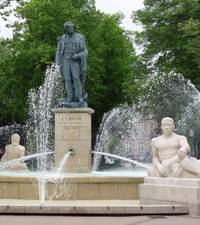
Joseph Bruat
1864 : Statue of Joseph Bruat
Born in Colmar in 1796, Joseph was elevated to Bruat admiral. The city honored him by erecting the statue inaugurated in 1864. Initially on a sandstone basin, the fountain was destroyed by the German occupation of 1940. At the end of the war the monument was listed historical monument (1946) and a new basin was established in 1958. the heads of the original sculptures are kept in the Bartholdi museum Colmar.
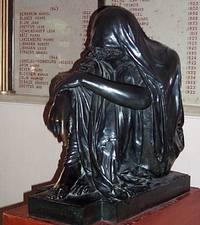
The funeral Engineering
1866 : The funeral Engineering
Pretty simple bronze work of Auguste Bartholdi, the statue of the pain of losing a loved one has been made to adorn the tomb of Georges Nefftzer, died at the age of 17 and buried in the Montmartre cemetery. The family donated Nefftzer later made the Colmar Bartholdi High School, who settled on the stairs.
1866 : Edouard de Laboulaye Bust
Edouard de Laboulaye Bust, friend of Auguste Bartholdi, historian of the United states.
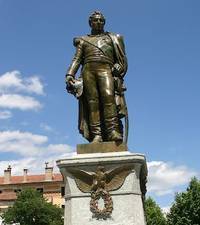
Statue of Arrighi de Casanova
1867 : Statue of Arrighi de Casanova
This statue was inaugurated May 17, 1867 in Corte, Corsica. Conceived and built by Auguste Bartholdi, including the base, it stands on the square dedicated to him, that of the Duke of Padua. It is a bronze statue, cast by Thiebaut workshops. Its funding was provided by a public subscription when Napoleon III versa 2,000 francs.
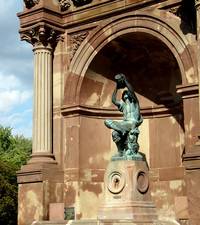
The Alsatian winegrower
1869 : The Alsatian winegrower
Commissioned by the city to Bartholdi is in 1869 that he gave his "Alsatian winemaker", a small statue set up in a niche of the south-western corner of the hall of the Covered Market. Today this statue is immune to the Bartholdi Museum Colmar, a replica took its place in the public space. Note the presence of another replica in Princeton, the United States, it was offered to the Americans following the twinning of the two cities.
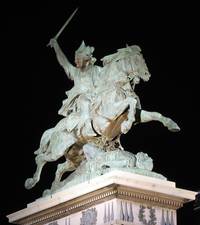
Vercingétorix
1870 : Statue of Vercingétorix
Made in 1870 by Auguste Bartholdi, the equestrian statue of Vercingetorix is a monumental bronze work placed on a pedestal in grandiloquent downtown Clermont-Ferrand. It was put there in 1903 (opening October 12, 1903), after having been exposed to the 1900 World Exposition, then repatriated to Clermont-Ferrand in 1902 in the courtyard of the University Palace. For the record, you should know that the opening day was memorable: The influx of guests was such that the food missed the banquet that followed, and the day ended in a horrible fight that ends up in court ...
1870 : Funerary monument of Marguerite Louise Scheurer
Auguste Bartholdi was in 1870 a funerary marble medallion in memory of Marguerite Louise Scheurer, fellow citizen born Berdot Colmar (Colmar, 1832-1870). It is visible in the cemetery of Ladhof.
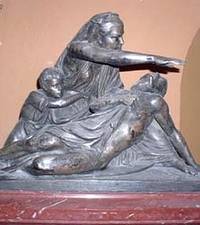
At Gambetta the Alsatians grateful
1872 : At Gambetta the Alsatians grateful
It is a bronze set of modest size compared to his other works. The statue depicts a woman holding in his arms his dead husband, she has a vengeful air. A child accompanies it. This staging is the loss of Alsace-Lorraine in the War of 1870, very close. Funding was provided by a public subscription, 12 cities and gave their seals found on the statue. The base is in red marble.
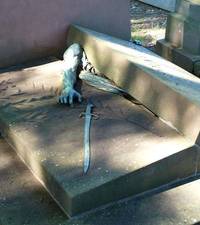
Funerary monuments of the National Guard
1872 : Funerary monuments of the National Guard
This is a rather original work that this monument, it is two loose stones tombstones letting the arm of a fighter trying to catch a bayonet. This monument was funded by public subscription in 1871. Deteriorated by the Germans in 1940, it was restored in 1945. It is made of marble and bronze.
1872 : Tombstones Gustave Saltzmann
This monument is in memory of the painter Gustave Saltzmann (Colmar, 1811 - Nyon, Switzerland, 1872). It is the cemetery of Lancy, Switzerland.
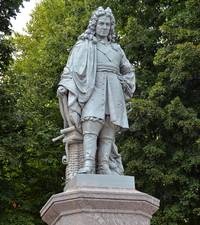
Vauban
1873 : Statue of Vauban
On a request of 1866, Bartholdi realized in 1972 the statue of Vauban in great serenity posture for the city of Avallon. She was cast in the workshops of Barbedienne and was inaugurated at the end of the parade, 26 October 1873. The time taken to execute this command is justified by two elements: a disagreement with a Council representative civil buildings Felix Duban, and his trip to the United States, conducted in 1871, eastern France being then under Prussian domination.
1874 : Low-relief Boston Baptist Unitarian Church
American order, Bartholdi sculpted four trumpeters angels representing the Four Stages of Christian life. It is a relief on the bell tower of the Church First Baptist Church in Brattle Street, Boston (USA).
1874 : Eardrum church, Boissy St Léger
The eardrum of Boissy St Léger church was sculpted by Bartholdi in 1874.
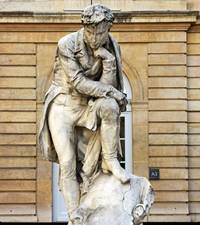
Champollion
1875 : Statue of Jean-François Champollion
This statue was originally scheduled to be made of bronze, but the cost was too high. Auguste Bartholdi decided, then to the marble, he carved a block. The statue was acquired by the Department of Fine Arts and in the courtyard of the College de France, following its exposure to room 1875. The original plaster realized in 1867 was given to the city of Grenoble by the widow of Bartholdi, who put away for 60 years in the premises of Champollion school. In 1995 this plaster was back at the museum in Grenoble, where he had been very temporarily exposed.
1875 : Brisach's Defenders
Sculpture dedicated to the defenders of the town of Brisach Neuf-Brisach. She is at the door of Basel.
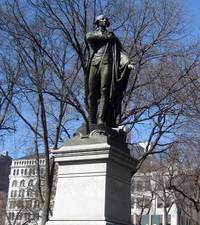
Lafayette
1876 : Statue of Lafayette
This bronze statue is a tribute to General Lafayette, who brought his French military genius and his troops to the cause of independence of the United States. Made in 1873 and inaugurated in 1876, this statue is a gift to thank the United States for help brought to France during the war of 1870.
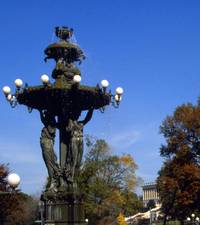
Fountain of the Capitol
1878 : Fountain of the Capitol
The fountain is near Capitol ... Capitol, the seat of the US Congress, the Bartholdi Park. It is a work performed inaugurated in 1878 and presented at the exhibition of the centenary of Philadelphia in 1876.
1879 : Statue of Gribeauval
The statue of Gribeauval is in the court of the invalids in Paris.
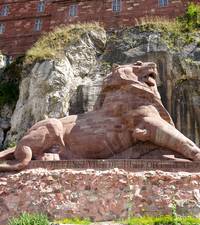
Lion of Belfort
1880 : Lion of Belfort
LThe Lion of Belfort is a statue commemorating the resistance of the city of Belfort against the Prussian occupier during the siege of 1870-1871. Originally it was to be a mere statue without much importance, but Auguste Bartholdi saw it big and proposed a symbol of power and fury, lion. This is roaring, full of life, one feels hurt but aggressive: All the picture would receive the city with that request. It was a historical monument in 1931.
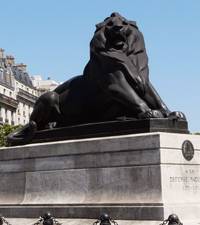
Replica of the Lion of Belfort
1880 : Replica of the Lion of Belfort (Paris)
This is a replica of the Lion of Belfort, built from a plaster model to a third of the normal size. Presented at the 1878 show in Paris, the outcome of this plaster statue was purchased by the city of Paris for 20,000 francs. It was installed on Place Denfert-Rochereau an imposing pedestal. It must be said that the statue itself, made of copper plates rejected, measuring 7m long.
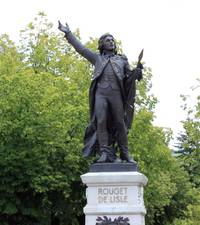
Rouget de l'Isle
1882 : Statue of Rouget de l'Isle, Lons-le-Saunier
Originally from Lons-le-Saunier, Rouget de l'Isle was a French officer. He is known for being the author of Marseille, the French national anthem. His statue was made by Auguste Bartholdi, it was inaugurated in 1882.
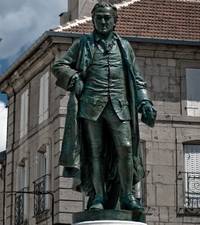
Statue of Diderot, Langres
1884 : Statue of Diderot, Langres
This bronze statue is located in Langres. It is placed on a site Diderot low cylindrical stone pedestal, which enables a better view of the statue. The latter is bronze, it was inaugurated in 1884, during the end of the construction of the Statue of Liberty.
1884 : Museum of Fine Arts
Between 1877 and 1884 Auguste Bartholdi worked on the building of the Fine Arts Museum of Rouen, he carved decor.
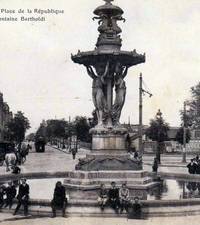
Bartholdi fountain, Reims
1885 : Bartholdi foutain, Reims
This fountain was commissioned by the city of Rheims. It consisted of three back to back caryatids supporting a basin from which the water flowed. Installed Republic Square, it was destroyed during the First World War and finally dismantled in 1923. She was known as the "Bartholdi Fountain", proof that the name of the sculptor was in 1885, widely known.
1885 : funeral medallion of Charles Penquer
Another funeral medallion, that one is in memory of Charles Auguste François Salaun Penquer (Lesneven, 1809 - Brest), mayor of Brest in 1882 (1871-1881). Bartholdi sculpted ornaments from the tomb of the deceased who is in the cemetery of St Martin Brest.
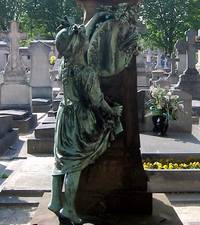
Jundt funerary monument
1885 : Gustave Jundt funerary monument
Very original monument, composed of a little girl reaching for the bust of the deceased. This monument is visible in Montparnasse cemetery in Paris. Gustave Jundt was a painter. (Strasbourg, 1830 - Paris, 1884)
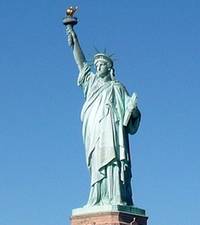
Statue of Liberty
1886: The statue of Liberty, New-York
This statue is a masterpiece of Bartholdi, the website dedicated to him. See the other pages of this website for details.
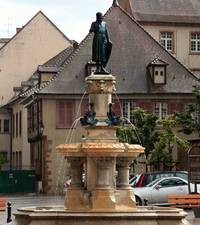
Roesselmann fountain
1888 : Roesselmann fountain
Jean Roesselmann was a provost of Colmar, who died in 1262 defending the independence of the city facing the bishop of Strasbourg. The city of Colmar worshiped him in 1888 with the bronze statue. Note that the face of the statue is that of Hercules Peyerimhoff, mayor, forced to abandon his mandate facing the German authorities during the 1871 annexation period.
1888 : funerary monument Paul Bert
Paul Bert was resident general of Tonkin in Vietnam. Bartholdi sculpted his tomb (Auxerre, 1833 - Hanoi, 1886), whose grave is in the cemetery St Amâtre at Auxerre.
1890 : Funerary monument Emile Hubner
Funerary monument Emile Hubner (Mulhouse, 1821 - Paris, 1888). He was an engineer and industrialist. His grave is in the cemetery of the Avenue du Repos in Mulhouse.
1890 : Funerary monument André Robberechts
Funerary monument Robberechts André (Brussels, 1798 - Paris, 1860), violinist and composer. His grave is located in Montparnasse Cemetery in Paris.
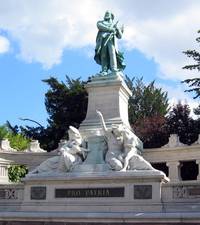
Gambetta
1891 : Statue of Gambetta
It is near the St Cloud park lies this lovely monument to Gambetta. The statue itself is bronze but the other statues are marble. They represent mothers courage in adversity of the country. It must be said that this monument was built by the will of Alsace and Lorraine, then under Prussian protection.
1890 : Funerary monument Théodore Deck
Funerary monument of Théodore Deck (Guebwiller, 1823 - Sevres, 1891), ceramist. Bartholdi realized in the ornaments of the tomb, which is located in Montparnasse Cemetery in Paris.
1890 : Funerary monument Jean-François Soitoux
Tomb of Jean-François Soitoux (Besançon, 1816 - Paris, 1891). It was made in collaboration with Maximilien Bourgeois. This is a sculpture, it is in the Montparnasse cemetery in Paris.
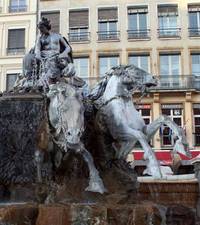
Bartholdi fountain
1892 : Bartholdi fountain
This fountain is a beautiful bronze equestrian set. It was built in 1888, it was originally to be delivered to the city of Bordeaux, which refused it because of its high cost. Shown at the 1889 World Expo it was bought by the city of Lyon to adorn the place of Soils in 1891. The changes place in 1992. It represents France in the Marianne traits and 4 rivers of France (horses).
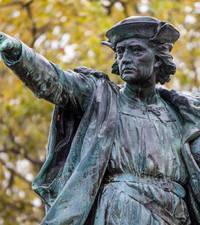
Colombus
1893 : Colombus
This monument is located in Rhodes Island, United States, in the city of Providence, much frequented by American personalities of the era.
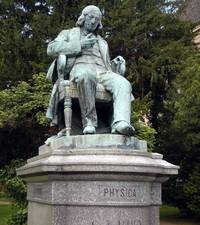
Gustave Hirn
1894 : Statue of Gustave Hirn
Gustave Adolphe Hirn was a physicist, mathematician, astronomer and philosopher whose knowledge has been applied in the execution of industrial machinery. This statue is commemorating the bronze, it was inaugurated in 1894.
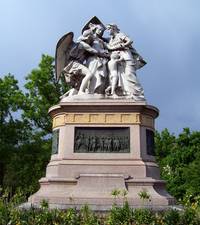
Switzerland rescuing Strasbourg
1895 : Switzerland rescuing Strasbourg
It is a marble sculpture of Auguste Bartholdi, in place in Basel (Switzerland). It shows a group of 4 characters. One represents Switzerland, protective of the city of Strasbourg (second character) which is supported by the love of the Fatherland (third character). The fourth character is a child crying.
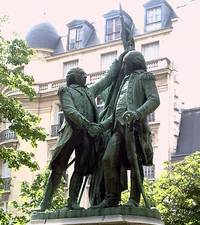
Lafayette and Washington
1895 : Statues of Lafayette and Washington
Placing on the place of the United States, replacing a replica of the Statue of Liberty as the United States have offered to France in appreciation of the real statue, this set shows two figures, one French, one American , pregnant in the history of United States. This set is bronze, it was offered by the United States to France. It is on the top of the square.
1896: Funerary monument of Frédéric Faudel
Funeral bronze medallion dedicated to Frederick Faudel (Colmar, 1826-1893), physician, archaeologist, naturalist. Bartholdi was the ornament of the tomb of the deceased, now in the Bartholdi Museum Colmar.
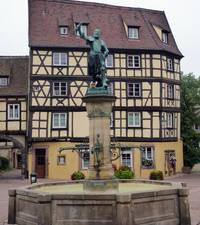
Lazare of Schwendi fountain
1898 : Lazare of Schwendi fountain
Lazare Schwendi was the commander of the Hungarian imperial army in the sixteenth century (1522-1583). His feat of arms is to have brought the grape variety in Alsace Tokay is why the statue in his hand brandishes a bunch of grapes of this grape. This statue is bronze, it was inaugurated in 1898, is on top of a fountain that was destroyed during the Second World War and rebuilt in a more modern style.
1896 : funerary monument of Georges Kern
Funeral Medallion of Georges Kern (Eckartswiller 1820 - Colmar, 1898), organist, composer. Bartholdi was the ornament of the grave of the deceased.
1901 : Monuments of French soldiers killed, in Schinznach
It is in Switzerland, at the cemetery in Birr-bei-Brugg.
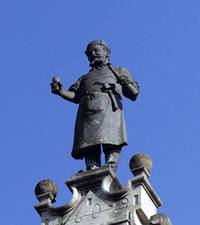
Alsatian cooper
1902 : Alsatian cooper
The statue was commissioned by the wine exchange in Colmar, a facility that was converted in 1898 in a renaissance style building. The statue was intended to magnify the facade, overcoming its pinion. It was inaugurated in 1902. In a rather unusual way, this statue was made of bronze.
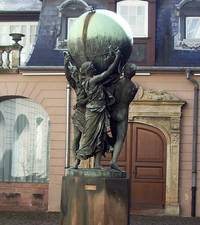
Great support of the World
1902 : Great support of the World
Completed in 1902, this statue represents the allegories of Justice, Patriotism and Labour, the three pillars of the functioning of the World according to the sponsors of the statue. The latter was installed in 1909 in the courtyard of the Bartholdi Museum Colmar. It was also presented in 1902 at the Paris Salon.
1904 : Funerary monument du Sergent Hoff
Funerary monument Sergeant Hoff (Marmoutier, 1836 - Paris, 1902). This is a posthumous work located in Pere Lachaise in Paris.
1906 : Memorial to balloons and pigeons of the Siege of Paris ...
This is a posthumous work. Its exact title is very long: 'Monument in memory of balloons and pigeons of Paris Headquarters; the heroes of the postal, telegraph, railways, aeronauts and pigeon fanciers of 1870-1871 '. It was destroyed in 1941.
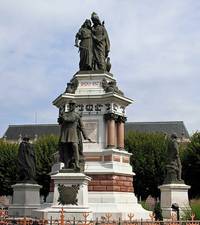
Monument of the three seats
1913 : Monument of the three seats
This monument is a posthumous work of Auguste Bartholdi, the fact that the plans will be drawn. These are his pupils Christmas Louis and Jules Déchin who realized. The monument represents France (The 4 characters of the summit) protected by Denfert-Rochereau, Lecourbe and Legrand, the 3 officers defenders of the city of Belfort during the three seats in 1814, 1815 and 1870.






